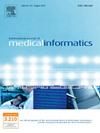Nutritional and lifestyle predictors of rectal bleeding in functional constipation: A machine learning approach
IF 3.7
2区 医学
Q2 COMPUTER SCIENCE, INFORMATION SYSTEMS
International Journal of Medical Informatics
Pub Date : 2025-05-08
DOI:10.1016/j.ijmedinf.2025.105963
引用次数: 0
Abstract
Background
Rectal bleeding among young adults is an increasingly common clinical concern often linked with chronic constipation and unhealthy lifestyle habits. Early identification of at-risk individuals through machine learning models-based approach may help in prevention and targeted intervention.
Objectives
We aim to identify dietary and lifestyle risk factors for rectal bleeding and to develop machine learning-based models for risk prediction.
Methods
A descriptive observational study was conducted on 875 Indian college going participants. A structured questionnaire assessed fiber intake, physical activity, constipation symptoms, and body mass index (BMI). Multiple machine learning algorithms were evaluated, and their performance was assessed using accuracy and area under the receiver operating characteristic curve (ROC-AUC).
Results
Low intake of boiled vegetables or oatmeal (<50 g/day) was associated with a 43.92 % bleeding rate (p < 0.001). Participants consuming inadequate whole grains (>25 g/day) showed a 44.81 % bleeding rate. Overweight or obese individuals exhibited a significantly higher bleeding incidence (12.26 %) than those with normal BMI (5.55 %; p = 0.008). The KNeighbors Classifier showed the highest accuracy (98.86 %) and ROC-AUC (0.994). Variables related to symptoms had greater predictive importance than those related to lifestyle.
Conclusions
The findings support the role of dietary fiber and BMI in the development of rectal bleeding in constipated individuals. The predictive models demonstrate strong potential for identifying at-risk individuals and is considered a simple and useful tool for predicting rectal bleeding in functional constipation, suggesting preventive health strategies and dietary modifications. This novel algorithm might enable clinicians to perform personalized dietary strategies with improved clinical outcomes. Further validation across larger and more diverse populations is recommended.
功能性便秘患者直肠出血的营养和生活方式预测因素:机器学习方法
背景:在年轻人中直肠出血是一种越来越常见的临床问题,通常与慢性便秘和不健康的生活习惯有关。通过基于机器学习模型的方法早期识别高危个体可能有助于预防和有针对性的干预。我们的目标是确定直肠出血的饮食和生活方式风险因素,并开发基于机器学习的风险预测模型。方法对875名印度大学生进行描述性观察研究。一份结构化问卷评估了纤维摄入量、身体活动、便秘症状和身体质量指数(BMI)。对多种机器学习算法进行了评估,并使用准确度和接受者工作特征曲线(ROC-AUC)下的面积来评估它们的性能。结果缓慢摄入水煮蔬菜或燕麦片(50 g/d)与43.92%的出血率相关(p <;0.001)。摄入不足的全谷物(每天25克)的参与者出血率为44.81%。超重或肥胖个体的出血发生率(12.26%)明显高于BMI正常者(5.55%;p = 0.008)。KNeighbors分类器准确率最高(98.86%),ROC-AUC最高(0.994)。与症状相关的变量比与生活方式相关的变量具有更大的预测重要性。结论:研究结果支持膳食纤维和BMI在便秘个体直肠出血发展中的作用。预测模型显示了识别高危个体的强大潜力,被认为是预测功能性便秘直肠出血的简单而有用的工具,建议预防健康策略和饮食调整。这种新颖的算法可能使临床医生能够执行个性化的饮食策略,改善临床结果。建议在更大、更多样化的人群中进一步验证。
本文章由计算机程序翻译,如有差异,请以英文原文为准。
求助全文
约1分钟内获得全文
求助全文
来源期刊

International Journal of Medical Informatics
医学-计算机:信息系统
CiteScore
8.90
自引率
4.10%
发文量
217
审稿时长
42 days
期刊介绍:
International Journal of Medical Informatics provides an international medium for dissemination of original results and interpretative reviews concerning the field of medical informatics. The Journal emphasizes the evaluation of systems in healthcare settings.
The scope of journal covers:
Information systems, including national or international registration systems, hospital information systems, departmental and/or physician''s office systems, document handling systems, electronic medical record systems, standardization, systems integration etc.;
Computer-aided medical decision support systems using heuristic, algorithmic and/or statistical methods as exemplified in decision theory, protocol development, artificial intelligence, etc.
Educational computer based programs pertaining to medical informatics or medicine in general;
Organizational, economic, social, clinical impact, ethical and cost-benefit aspects of IT applications in health care.
 求助内容:
求助内容: 应助结果提醒方式:
应助结果提醒方式:


